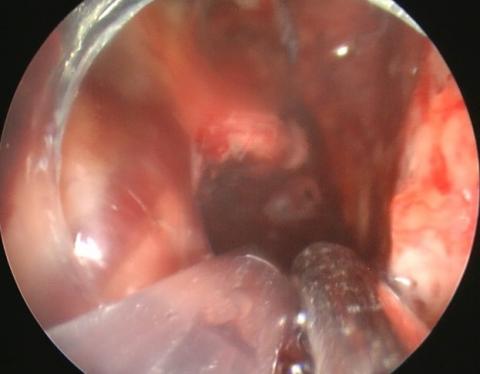Usted está aquí
Peruvian Journal of Neurosurgery
Evacuation of intracerebral hematomas by Neuroendoscopy: results in a series of cases
ABSTRACT
Objectives: Intracerebral (ICH) and intraventricular (IVH) hemorrhage cause severe morbidity and a high mortality rate. Intracranial hypertension and secondary injury in the perihematomal region are associated with a poor prognosis, so early surgical evacuation with minimal damage to brain tissue is essential. Endoscopic evacuation using an Endoport system is a promising technique. The objective of the study is to present the results of the endoscopic evacuation of ICH and IVH in patients operated from 2010-2019 at the Almenara Hospital in Lima-Peru.
Methods: Prospective descriptive study, in a period of 10 years, 48 patients with ICH and IVH underwent endoscopic evacuation in the first 72 hours, using a transparent working channel (Endoport) designed from a 3cc syringe. Postoperative evaluation was done with tomography and neurological follow-up using the Glasgow Coma Scale.
Results: Of a total of 48 cases, 30 were ICH, and 18 were IVH. The most frequent etiology was hypertension (75%), followed by an arteriovenous malformation (19%) and cerebral aneurysm (6%). The most frequent location was the basal nuclei at the putaminal level (29%) and the thalamic region (29%), followed by the subcortical region (17%) and posterior fossa (6%). The evacuation rate was 90% in ICH and 80% in IVH. There were no intraoperative complications, and the most frequent postoperative complication was in-hospital pneumonia (37%). The average time of external drainage in the IVH was 7.6 days. All patients showed improvement in the Glasgow Scale of an average of 4 points (8.8 in the preoperative period to 13.0 in the postoperative period). Overall mortality was 19% (20% in ICH and 16.7% in IVH)
Conclusions: The endoscopic evacuation of an intracranial hematoma is an effective, minimally invasive, and feasible technique to carry out. A modified 3cc syringe can be used as a working channel. This provides enough space for adequate visualization of the hematoma, as well as for the control of intraoperative bleeding.
Keywords: Cerebral Hemorrhage, Hematoma, Endoscopy, Syringes, Intracranial Hypertension. (source: MeSH NLM)



